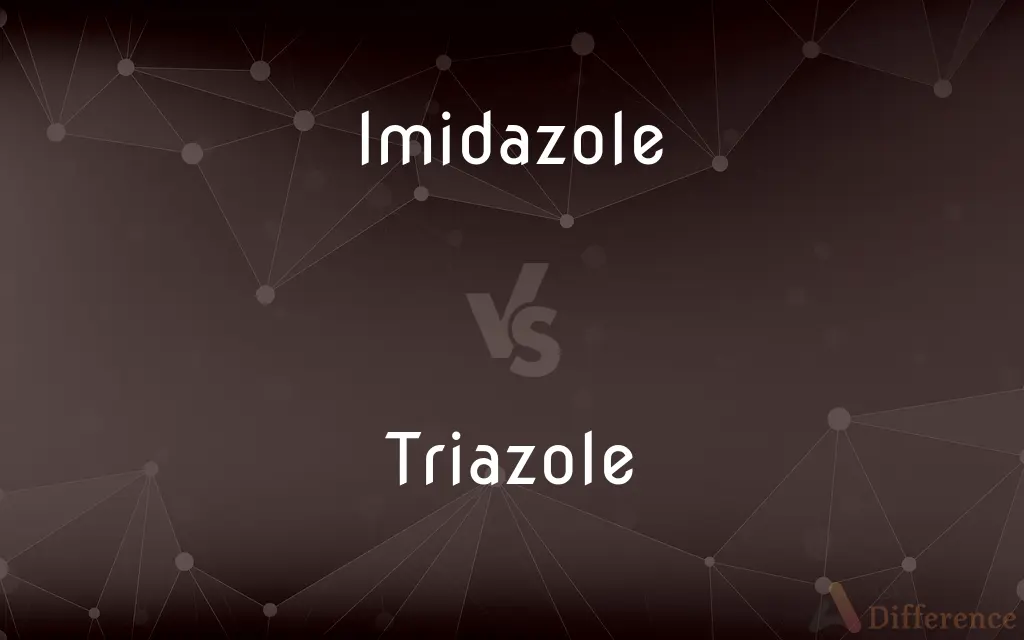Imidazole vs. Triazole — What's the Difference?
Edited by Tayyaba Rehman — By Fiza Rafique — Updated on March 20, 2024
Imidazole is a five-membered ring compound containing two nitrogen atoms at positions 1 and 3, essential in biology and synthesis, whereas triazole has a similar ring but with three nitrogen atoms, offering distinct chemical properties and applications.

Difference Between Imidazole and Triazole
Table of Contents
ADVERTISEMENT
Key Differences
Imidazole features a ring structure with two nitrogen atoms, making it a versatile compound used in a wide range of applications, from pharmaceuticals to agriculture. Its structure allows for the formation of hydrogen bonds, contributing to its solubility and reactivity. On the other hand, triazole contains three nitrogen atoms within its five-membered ring, which significantly alters its chemical properties, including enhanced nitrogen content, increased ring stability, and a tendency to form more robust hydrogen bonds compared to imidazole.
The presence of nitrogen atoms in imidazole's structure makes it a crucial component in biological molecules, such as histidine and histamine, playing significant roles in enzyme action and metabolism. Triazole, meanwhile, finds extensive use in pharmaceuticals, agriculture, and materials science due to its increased stability and ability to act as a more effective chelating agent, binding with metals and other substances.
In terms of synthesis, imidazole is synthesized through several methods, including the Radziszewski synthesis, which involves condensing glyoxal with formaldehyde and ammonia. Triazole synthesis often involves the cyclization of azides and nitriles, showcasing its distinct synthetic routes that exploit its unique nitrogen configuration for creating diverse derivatives.
The applications of imidazole extend into materials science, where it's used as a corrosion inhibitor and in polymers, due to its ability to donate and accept electrons. Triazole derivatives, however, are particularly valued in creating antifungal agents, given their robust structure that provides effective disruption of fungal cell membrane synthesis.
While imidazole's moderate electron density and polarity make it an excellent ligand in coordination chemistry, enabling the formation of complex structures with metals, triazole stands out in more specialized applications, such as in the synthesis of advanced materials and pharmaceuticals, where its extra nitrogen atom offers unique bonding and reactivity traits.
ADVERTISEMENT
Comparison Chart
Nitrogen Atoms
Two, at positions 1 and 3 of the ring.
Three, more evenly spread across the ring.
Ring Stability
Moderately stable, with some reactivity.
More stable due to additional nitrogen atom.
Biological Role
Found in histidine and histamine; crucial for enzyme function.
Less common in biology, used more in synthetics.
Synthesis
Involves condensing glyoxal with formaldehyde and ammonia.
Often produced by cyclization of azides and nitriles.
Applications
Pharmaceuticals, agriculture, materials science as corrosion inhibitors.
Pharmaceuticals (especially antifungals), agriculture, advanced materials.
Compare with Definitions
Imidazole
Can donate or accept electrons, making it useful in polymer chemistry.
Imidazole groups improve the thermal stability of polymers.
Triazole
Utilized in the synthesis of pharmaceuticals and agrochemicals.
Triazole derivatives serve as core structures for new drugs.
Imidazole
A heterocyclic compound with a five-membered ring containing two non-adjacent nitrogen atoms.
Imidazole is a key component of the amino acid histidine.
Triazole
A heterocyclic aromatic compound with three nitrogen atoms in a five-membered ring.
Triazole rings are found in many potent antifungal agents.
Imidazole
Found in many biological molecules with pivotal roles.
Histamine, involved in immune responses, contains an imidazole ring.
Triazole
Acts as a chelating agent in various chemical reactions.
Triazole complexes with metals for use in catalysis.
Imidazole
Used as a building block in the synthesis of many drugs.
Imidazole-based compounds are common in antifungal medications.
Triazole
Key in materials science for creating advanced materials.
Triazole compounds are incorporated into polymers for enhanced properties.
Imidazole
Acts as a corrosion inhibitor in industrial applications.
Imidazole derivatives protect metals from rusting.
Triazole
Offers greater ring stability and nitrogen content than imidazole.
Triazole-based herbicides are highly effective and stable.
Imidazole
Imidazole is an organic compound with the formula C3N2H4. It is a white or colourless solid that is soluble in water, producing a mildly alkaline solution.
Triazole
A triazole refers to any of the heterocyclic compounds with molecular formula C2H3N3, having a five-membered ring of two carbon atoms and three nitrogen atoms. There are two sets of isomers that differ in the relative positions of the three nitrogen atoms.
Imidazole
An organic crystalline base, C3H4N2, that is an inhibitor of histamine.
Triazole
One of two isomeric aromatic compounds with composition C2H3N3, having a five-membered ring of two carbon atoms and three nitrogen atoms.
Imidazole
Any of various derivatives of this compound, which often have antifungal, anthelmintic, or antibiotic properties.
Triazole
A compound derived from one of these isomers.
Imidazole
(organic compound) A heterocyclic organic compound containing two nitrogen atoms separated by a carbon atom in a five-membered ring, called 1,3-diazole in IUPAC nomenclature.
Triazole
(organic compound) Either of two isomeric heterocyclic compounds having a five-membered ring with three nitrogen atoms and two double bonds in the ring; any organic derivative of these compounds.
Imidazole
(organic compound) A group of compounds containing that structure.
Imidazole
An organic base C3H4N2; a histamine inhibitor
Common Curiosities
What role does imidazole play in biological systems?
Imidazole is integral to the structure of key biological molecules like histidine and histamine, influencing enzyme function and immune responses.
What makes triazole more stable than imidazole?
The presence of an additional nitrogen atom in triazole enhances its ring stability compared to imidazole.
In what types of industrial applications are imidazole and triazole found?
Imidazole is used as a corrosion inhibitor and in polymers, while triazole finds applications in pharmaceuticals, agrochemicals, and advanced materials.
Can imidazole and triazole act as ligands in coordination chemistry?
Yes, both can act as ligands due to their ability to donate electron pairs, but their coordination properties differ due to their nitrogen atom configurations.
What distinguishes imidazole from triazole?
The key difference is the number and position of nitrogen atoms in their rings, affecting stability, reactivity, and applications.
How does the presence of nitrogen atoms affect the properties of imidazole and triazole?
Nitrogen atoms contribute to ring stability, hydrogen bonding capacity, and reactivity, influencing each compound's chemical behavior and applications.
How are imidazole and triazole synthesized?
Imidazole synthesis often involves the Radziszewski synthesis, while triazole synthesis may utilize the cyclization of azides and nitriles, reflecting their structural differences.
How does the chemical reactivity of imidazole compare to triazole?
Imidazole tends to be more reactive due to its less saturated nitrogen configuration, whereas triazole's extra nitrogen atom grants it greater stability.
Why are triazole compounds commonly used in antifungals?
Triazole's increased ring stability and nitrogen content make it effective in disrupting fungal cell membranes, leading to its use in antifungal medications.
Are imidazole and triazole interchangeable in their applications?
Not usually, as their differing nitrogen content and ring stability lead to different chemical properties and thus distinct applications.
Share Your Discovery

Previous Comparison
CA vs. CS
Next Comparison
Worry vs. WarryAuthor Spotlight
Written by
Fiza RafiqueFiza Rafique is a skilled content writer at AskDifference.com, where she meticulously refines and enhances written pieces. Drawing from her vast editorial expertise, Fiza ensures clarity, accuracy, and precision in every article. Passionate about language, she continually seeks to elevate the quality of content for readers worldwide.
Edited by
Tayyaba RehmanTayyaba Rehman is a distinguished writer, currently serving as a primary contributor to askdifference.com. As a researcher in semantics and etymology, Tayyaba's passion for the complexity of languages and their distinctions has found a perfect home on the platform. Tayyaba delves into the intricacies of language, distinguishing between commonly confused words and phrases, thereby providing clarity for readers worldwide.















































